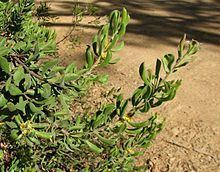Rank Species | ||
 | ||
Similar Persoonia chamaepeuce, Persoonia silvatica, Persoonia coriacea | ||
Persoonia rigida, commonly known as the rigid-, hairy- or stiff geebung, is a shrub native to New South Wales and Victoria in eastern Australia. First collected by George Caley in 1804, it was one of the many Australian plants first described by Scottish botanist Robert Brown, and still bears the binomial name he gave it in 1830. Within the genus Persoonia, P. rigida is classified in the lanceolata group, a group of 54 closely related species with similar flowers but very different foliage. These species will often interbreed with each other where two members of the group occur. It grows as a small shrub to 1 m (3.3 ft) high, and has hairy new branches and leaves. The narrow leaves measure 1.5 to 4.5 cm (0.59 to 1.77 in) long, and 0.4–1.9 cm wide and are spathulate or obovate in shape, with margins turning downwards. Appearing in summer, the inflorescences are composed of single yellow flowers and have hairy perianths. The proportion of flowers going on to develop fruit appears to be unusually high in P. rigida compared with other members of the genus.
Persoonia rigida is found from the Liverpool Range in Central New South Wales southwards into Central Victoria, where it reaches the Grampians National Park. It occurs on the inland (north and west) side of the Great Dividing Range, but extends eastwards to Springwood in the Lower Blue Mountains. The altitude ranges from 300 to 1,300 m (980 to 4,270 ft). It grows in sandstone-based or rocky soils in dry sclreophyll forest or heathland. It has been known to hybridise with the prickly geebung (P. juniperina), as well as P. sericea. Associated tree species in Victoria include Eucalyptus macrorhyncha andEucalyptus polyanthemos.
Persoonia rigida was cultivated in England in 1824 but is seldom seen in gardens now, and has little horticultural appeal.
